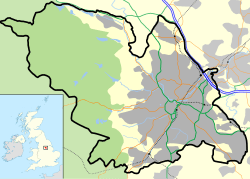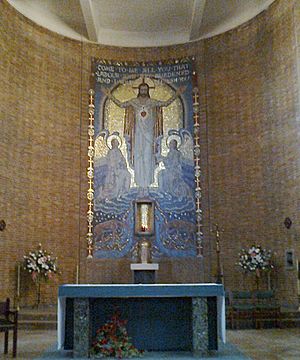Sacred Heart Church, Hillsborough facts for kids
Quick facts for kids Sacred Heart Church |
|
|---|---|

Sacred Heart Church seen from Ripley Street.
|
|
| 53°24′04″N 1°29′57″W / 53.4012°N 1.4993°W | |
| Location | Hillsborough, Sheffield |
| Country | England, United Kingdom |
| Denomination | Roman Catholic |
| History | |
| Founded | 5 August 1920 |
| Dedicated | 7 March 1947 |
| Architecture | |
| Heritage designation | Grade II |
| Architect(s) | C.M. Hadfield |
| Style | Romanesque Revival |
| Construction cost | £13,000 |
| Specifications | |
| Bells | 8 |
| Administration | |
| Parish | Sacred Heart Hillsborough |
| Deanery | Sheffield North |
| Diocese | Diocese of Hallam |
Sacred Heart Church is a beautiful Catholic church located in the Hillsborough area of Sheffield, England. You can find it on Forbes Road. This church is quite special because it's a Grade II listed building, which means it's an important historical place. Its tall tower stands out and can be seen from far away, making it a well-known landmark in the area.
Contents
History of Sacred Heart Church
For many years, starting in the 1850s, Catholic people in Hillsborough and Lower Walkley went to church at the Hillsborough Barracks chapel. As more and more people moved to the area, a bigger place to worship was needed.
Building the First Chapel-School
On July 19, 1903, a new building called the Sacred Heart school-chapel was opened. It was built on land between Forbes Road and Ripley Street, which cost £1,080. This building was designed by an architect named C.M. Hadfield. It served as a smaller chapel for the main St Vincent's parish and cost £3,000 to build. This original building is still used today and is home to the Sacred Heart Primary School.
Becoming an Independent Parish
The Sacred Heart parish in Hillsborough became its own independent church community in 1920. This happened on August 5 of that year, meaning it was no longer part of St Vincent's. The first priest for the new parish was R.J. Dunford. At first, Father Dunford held Mass in the chapel-school.
A temporary church was set up and opened in February 1921, costing £3,000. It took a few more years before work began on the permanent church building.
Constructing the Permanent Church
Construction on the main church started in May 1935. On July 7 of that year, the foundation stone was laid by Joseph Cowgill, who was the Roman Catholic Bishop of Leeds. The church cost £13,000 to build. A large part of this money, £10,000, was given by the widow of Philip Wake, a local magistrate.
The church officially opened on March 25, 1936, with a special High Mass. Richard Downey, the Archbishop of Liverpool, gave the sermon.
Exploring the Church Building
The Sacred Heart Church was designed by architect C. M. Hadfield. He was part of the Hadfield & Son firm. The church is built with special thin red bricks that have an interesting texture. The way the bricks are laid, called Monk bond, is quite unusual and rarely seen. Many people consider it one of the best churches built in Sheffield between the two World Wars.
Bells and Sculptures

When the church was first built, it had one large bell made by John Taylor Bellfounders in Loughborough. This bell is very heavy, weighing over one ton, and rings in the note of "D". In 1948, the bell tower was made stronger, and a set of smaller bells was added by the same company. These bells can be played like a carillon, which is a musical instrument made of bells.
A sculptor named Philip Lindsey Clark created many beautiful artworks for the church. He carved the 14 Stations of the Cross, which are pictures or sculptures showing Jesus's journey to his crucifixion. These are placed around the inside walls of the church. He also made the statue of the Sacred Heart at the main entrance.
Above the main door, there's a carved stone panel called a tympanum, made of Portland stone. This carving shows scenes from a pilgrimage to Lourdes, a famous religious site. One of the figures in the water might be Alfred Wood, a person from the parish who was healed during a pilgrimage in 1930. Canon Dunsford, the first priest, and the architect, C.M. Hadfield, are also shown among the pilgrims in the carving.
Mosaics and Altar Changes
Eric Newton, an art critic, created the colorful mosaics inside the church. The most striking mosaic is a large figure of the Sacred Heart with angels in the apse, which is the curved area behind the altar. He also added more mosaics in the side chapels in 1961 to celebrate the church's 25th anniversary.
In the late 1960s, some changes were made to the sanctuary area, where the altar is located. These changes were a result of the Second Vatican Council, a big meeting that updated many Catholic practices. The altar was moved forward so that Mass could be celebrated facing the people. It was also made shorter, and the extra stone was used to create a table for the tabernacle, which holds the consecrated hosts. The tabernacle itself stayed in its original spot at the back of the sanctuary.
Roof Repairs
For several years, the church had problems with its flat roof leaking. In 1983, a slightly sloped roof was put in place to fix this issue. The roof was replaced again in the late 2000s to ensure the church stays in good condition.



